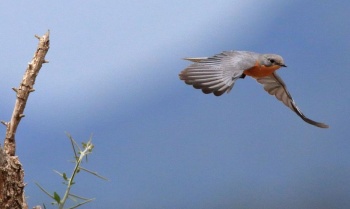(range description, reference updated) |
(Main picture changed. Flight picture added. Attempt to disguise some copied text. Some extra info) |
||
| Line 1: | Line 1: | ||
| − | [[Image: | + | [[Image:722 s sm filtered.jpg|thumb|550px|right|Photo by {{user|martinuk|martinuk}}<br />Murchison Falls National Park, Masindi District, [[Uganda]], July 2013]] |
;[[:Category:Empidornis|Empidornis]] semipartitus | ;[[:Category:Empidornis|Empidornis]] semipartitus | ||
| − | |||
==Identification== | ==Identification== | ||
| − | + | 18 cm (7 in) | |
| − | + | *Pale bluish-grey head and upperparts | |
| + | *Brownish-orange underparts<br /> | ||
| + | Juvenile: | ||
| + | *Black-bordered tawny spots on upperparts | ||
| + | *Mottled buff and black on throat and breast | ||
==Distribution== | ==Distribution== | ||
| + | [[Image:Silverbird flight.jpg|thumb|350px|right|Photo by {{user|nick+scarle|nick scarle}}<br />[[Serengeti National Park]], [[Tanzania]], November 2017]] | ||
Eastern [[Africa]]. Southwestern and southern [[Sudan]], [[South Sudan]], western [[Ethiopia]], eastern [[Uganda]], western [[Kenya]], and northern [[Tanzania]]. | Eastern [[Africa]]. Southwestern and southern [[Sudan]], [[South Sudan]], western [[Ethiopia]], eastern [[Uganda]], western [[Kenya]], and northern [[Tanzania]]. | ||
==Taxonomy== | ==Taxonomy== | ||
| − | + | This is a [[Dictionary_M-S#M|monotypic]] species<sup>[[#References|[1]]]</sup>.<br /> | |
Placed in genus ''[[:Category:Melaenornis|Melaenornis]]'' by Clements. | Placed in genus ''[[:Category:Melaenornis|Melaenornis]]'' by Clements. | ||
==Habitat== | ==Habitat== | ||
| − | + | Acacia grassland, semi-arid bushland with large scattered trees. | |
==Behaviour== | ==Behaviour== | ||
| − | They perch | + | ====Diet==== |
| + | Their main diet consists mostly of ground insects, such as ants and locusts. They sit on a perch and pounce on them. | ||
| + | |||
| + | They forage singly and in pairs. | ||
| + | ====Breeding==== | ||
| + | They are [[Dictionary_M-O#M|monogamous]] and a solitary nester. | ||
==References== | ==References== | ||
| − | #{{Ref-Clements6thAug17}} | + | #{{Ref-Clements6thAug17}}#Handbook of the Birds of the World Alive (retrieved Jan 2018) |
{{ref}} | {{ref}} | ||
==External Links== | ==External Links== | ||
| − | {{GSearch| | + | {{GSearch|Silverbird+semipartitus}} |
| + | |||
[[Category:Birds]] [[Category:Empidornis]] | [[Category:Birds]] [[Category:Empidornis]] | ||
Latest revision as of 22:12, 12 January 2018
- Empidornis semipartitus
Identification
18 cm (7 in)
- Pale bluish-grey head and upperparts
- Brownish-orange underparts
Juvenile:
- Black-bordered tawny spots on upperparts
- Mottled buff and black on throat and breast
Distribution
Eastern Africa. Southwestern and southern Sudan, South Sudan, western Ethiopia, eastern Uganda, western Kenya, and northern Tanzania.
Taxonomy
This is a monotypic species[1].
Placed in genus Melaenornis by Clements.
Habitat
Acacia grassland, semi-arid bushland with large scattered trees.
Behaviour
Diet
Their main diet consists mostly of ground insects, such as ants and locusts. They sit on a perch and pounce on them.
They forage singly and in pairs.
Breeding
They are monogamous and a solitary nester.
References
- Clements, J. F., T. S. Schulenberg, M. J. Iliff, D. Roberson, T. A. Fredericks, B. L. Sullivan, and C. L. Wood. 2017. The eBird/Clements checklist of birds of the world: v2017, with updates to August 2017. Downloaded from http://www.birds.cornell.edu/clementschecklist/download/
- Handbook of the Birds of the World Alive (retrieved Jan 2018)
Recommended Citation
- BirdForum Opus contributors. (2024) Silverbird. In: BirdForum, the forum for wild birds and birding. Retrieved 24 April 2024 from https://www.birdforum.net/opus/Silverbird





